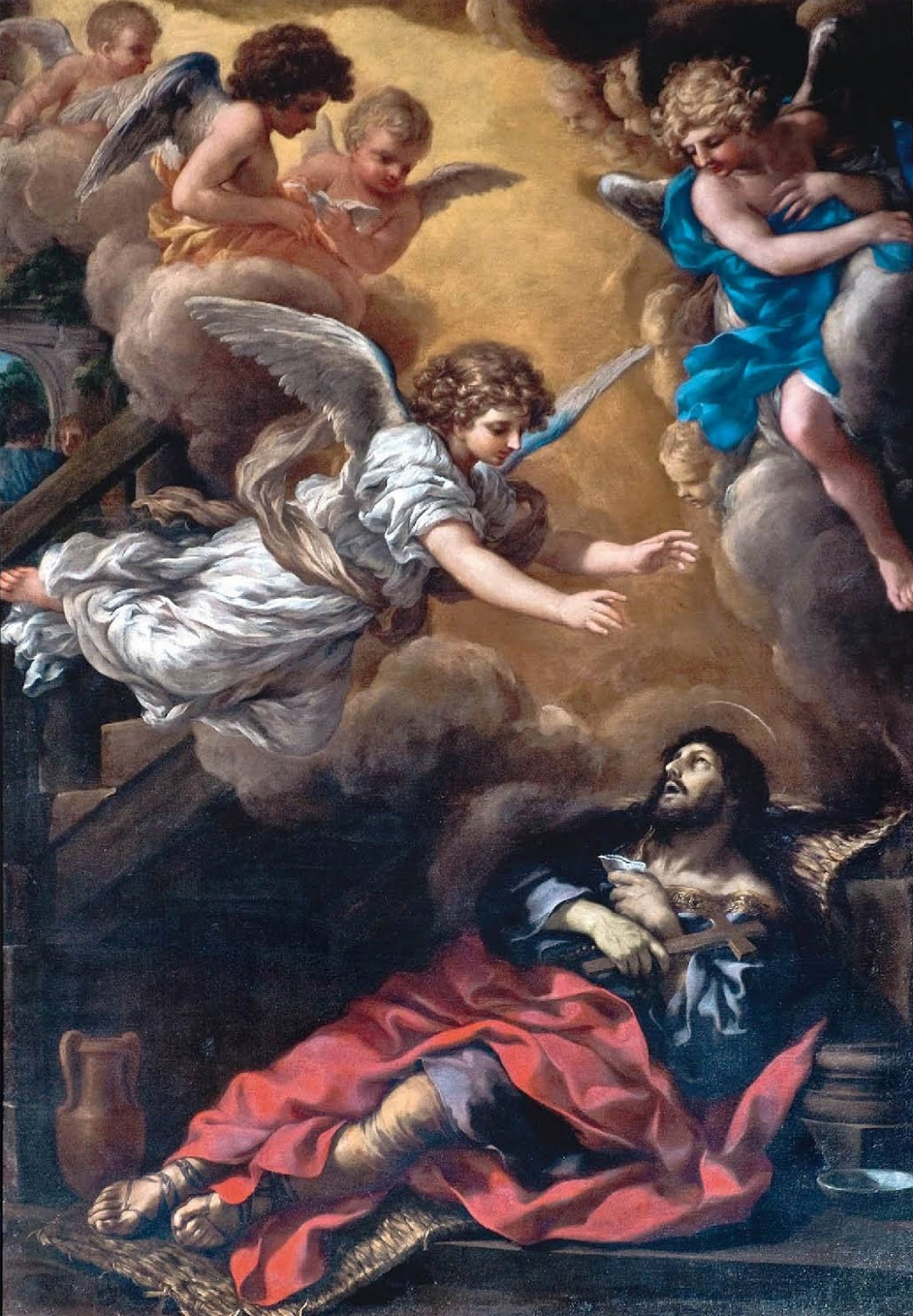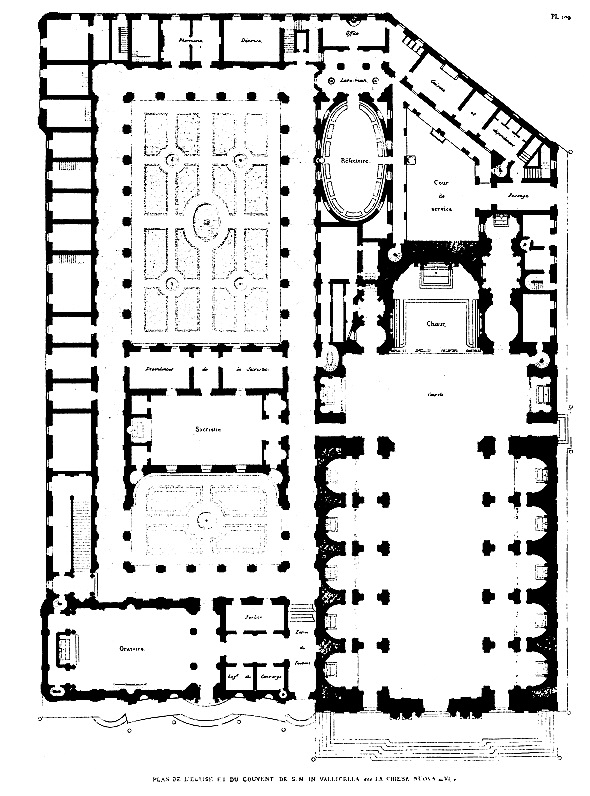|
The Death Of Saint Alexius
''The Death of Saint Alexius'' or ''Saint Alexius Dying'' is an oil on canvas painting by Pietro da Cortona, created ''c.'' 1638. It is held in the Saint Alexis chapel in the Girolamini, Naples. It shows the dying saint Alexius of Rome holding a letter welcomed by angels — he had left his family and returned to them at the moment of his death, with them only recognising him thanks to the letter. History It was commissioned by Anna Colonna, wife of Taddeo Barberini, nephew of pope Urban VIII, and later given to the Oratory of Saint Philip Neri, Oratorians of Naples with other relics and precious objects. The Barberini family had a particular devotion to Alexius, so much so that the opening show at their Palazzo's theatre was a sacred drama on that saint's life written by pope Clement IX, Giulio Rospigliosi with sets designed by da Cortona. Anna Colonna was deeply linked with the Oratorians' founder Philip Neri, owning a small bone of his in a reliquary by Alessandro Algardi, whic ... [...More Info...] [...Related Items...] OR: [Wikipedia] [Google] [Baidu] |
Alessandro Algardi
Alessandro Algardi (July 31, 1598 – June 10, 1654) was an Italian high-Baroque sculptor active almost exclusively in Rome. In the latter decades of his life, he was, along with Francesco Borromini and Pietro da Cortona, one of the major rivals of Gian Lorenzo Bernini, in Rome. He is now most admired for his portrait busts that have great vivacity and dignity. Early years Algardi was born in Bologna, where at a young age, he was apprenticed in the studio of Agostino Carracci. However, his aptitude for sculpture led him to work for Giulio Cesare Conventi (1577–1640), an artist of modest talents. His two earliest known works date back to this period: two statues of saints, made of chalk, in the Oratory of Santa Maria della Vita in Bologna. By the age of twenty, Ferdinando I, Duke of Mantua, began commissioning works from him, and he was also employed by local jewelers for figurative designs. After a short residence in Venice, he went to Rome in 1625 with an introduction from th ... [...More Info...] [...Related Items...] OR: [Wikipedia] [Google] [Baidu] |
Angels In Art
Angels have appeared in works of art since early Christian art, and they have been a popular subject for Byzantine Empire, Byzantine and European paintings and sculpture. Normally given wings in art, angels are usually intended, in both Christian and Islamic art, to be beautiful, though several depictions go for more awe-inspiring or frightening attributes, notably in the depiction of the Living creatures (Bible), living creatures (which have bestial characteristics), ophanim (which are wheels) and cherubim (which have mosaic features); As a matter of theology, they are spiritual beings who do not eat or excrete and are genderless. Many historical depictions of angels may appear to the modern eye to be gendered as either male or female by their dress or actions, but until the 19th century, even the most female looking will normally lack breasts, and the figures should normally be considered as genderless. In 19th-century art, especially funerary art, this traditional convention ... [...More Info...] [...Related Items...] OR: [Wikipedia] [Google] [Baidu] |
1638 Paintings
Events January–March * January 4 **A naval battle takes place in the Indian Ocean off the coast of Goa in South India as a Netherlands fleet commanded by Admiral Adam Westerwolt decimates the Portuguese fleet. **A fleet of 80 Spanish ships led by Governor-General Sebastián Hurtado de Corcuera attacks the Sultanate of Sulu in the Philippines by beginning an invasion of Jolo island, but Sultan Muwallil Wasit I puts up a stiff resistance. * January 8 – Shimabara Rebellion: The siege of Shimabara Castle ends after 27 days in Japan's Tokugawa shogunate (part of modern-day Nagasaki prefecture) as the rebel peasants flee reinforcements sent by the shogun Tokugawa Iemitsu. * January 22 – The Shimabara and Amakusa rebels, having joined up after fleeing the shogun's troops, begin the defense of Hara Castle in modern-day Minamishimabara in the Nagasaki prefecture. The siege lasts more than 11 weeks before the peasants are massacred. * February 28 – The Scotti ... [...More Info...] [...Related Items...] OR: [Wikipedia] [Google] [Baidu] |
Paintings Of Saints
Painting is a visual art, which is characterized by the practice of applying paint, pigment, color or other medium to a solid surface (called "matrix" or "support"). The medium is commonly applied to the base with a brush. Other implements, such as palette knives, sponges, airbrushes, the artist's fingers, or even a dripping technique that uses gravity may be used. One who produces paintings is called a painter. In art, the term "painting" describes both the act and the result of the action (the final work is called "a painting"). The support for paintings includes such surfaces as walls, paper, canvas, wood, glass, lacquer, pottery, leaf, copper and concrete, and the painting may incorporate other materials, in single or multiple form, including sand, clay, paper, cardboard, newspaper, plaster, gold leaf, and even entire objects. Painting is an important form of visual art, bringing in elements such as drawing, composition, gesture, narration, and abstraction. Paintings can ... [...More Info...] [...Related Items...] OR: [Wikipedia] [Google] [Baidu] |
Francesco Solimena
Francesco Solimena (4 October 1657 – 3 April 1747) was a prolific Italian Baroque painter, one of an established family of painters and draughtsmen. Biography Francesco Solimena was born in Canale di Serino in the province of Avellino. He received early training from his father, Angelo Solimena, with whom he executed a ''Paradise'' for the cathedral of Nocera Inferiore, Nocera (a place where he spent a big part of his life) and a ''Vision of St. Cyril of Alexandria'' for the church of San Domenico at Solofra. He settled in Naples in 1674, where he worked in the studio of Francesco di Maria.Pavone, Mario Alberto (2003, January 1). "Solimena family". Grove Art Online. He was patronized early on, and encouraged to become an artist by Cardinal Vincenzo Orsini (later Pope Benedict XIII). By the 1680s, he had independent fresco commissions, and his active studio came to dominate Neapolitan painting from the 1690s through the first four decades of the 18th century. He modeled h ... [...More Info...] [...Related Items...] OR: [Wikipedia] [Google] [Baidu] |
Chiesa Nuova, Rome
Santa Maria in Vallicella, also called Chiesa Nuova, is a churches of Rome, church in Rome, Italy, which today faces onto the main thoroughfare of the Corso Vittorio Emanuele II, Rome, Corso Vittorio Emanuele and the corner of Via della Chiesa Nuova. It is the principal church of the Oratory of Saint Philip Neri, Oratorians, a religious congregation of secular priests, founded by St Philip Neri in 1561 at a time in the 16th century when the Counter Reformation saw the emergence of a number of new religious institutes such as the Jesuits, the Theatines, and the Barnabites. These new congregations were responsible for several great preaching churches built in the Centro Storico, the others being Sant'Andrea della Valle (Theatines), San Carlo ai Catinari (Barnabites), and Church of the Gesù, The Gesù and Sant'Ignazio, Rome, Sant'Ignazio (Jesuits). History By tradition, Pope Gregory I, St. Gregory the Great built the first church on the site. By the 12th century, it was dedicated to ... [...More Info...] [...Related Items...] OR: [Wikipedia] [Google] [Baidu] |
Sacristy
A sacristy, also known as a vestry or preparation room, is a room in Christianity, Christian churches for the keeping of vestments (such as the alb and chasuble) and other church furnishings, sacred vessels, and parish records. The sacristy is usually located inside the Church (building), church, but in some cases it is an annex or separate building (as in some monastery, monasteries). In most older churches, a sacristy is near a side altar, or more usually behind or on a side of the high altar, main altar. In newer churches the sacristy is often in another location, such as near the entrances to the church. Some churches have more than one sacristy, each of which will have a specific function. Often additional sacristies are used for maintaining the church and its items, such as candles and other materials. Description The sacristy is also where the priest and attendants vest and prepare before the Church service, service. They will return there at the end of the service to r ... [...More Info...] [...Related Items...] OR: [Wikipedia] [Google] [Baidu] |
Philip Neri
Saint Philip Neri , born Filippo Romolo Neri, (22 July 151526 May 1595) was an Italian Catholic priest who founded the Congregation of the Oratory, a society of secular clergy dedicated to pastoral care and charitable work. He is sometimes referred to as the Second Apostle of Rome after Saint Peter. Neri's spiritual mission emphasised personal holiness and direct service to others, particularly through the education of young people and care for the poor and sick. His work played a significant role in the Counter-Reformation, especially within the city of Rome. Neri's early life in Florence and later move to Rome in 1533 marked the beginning of his dedication to missionary work. He initially gained prominence for his pastoral care and efforts to minister to marginalized communities, including prostitutes and the destitute. His passion for reform and personal holiness drew many followers, leading to the formation of the Church of the Most Holy Trinity of the Pilgrims and the Congr ... [...More Info...] [...Related Items...] OR: [Wikipedia] [Google] [Baidu] |
Pietro Da Cortona
Pietro da Cortona (; 1 November 1596 or 159716 May 1669) was an Italian Baroque painter and architect. Along with his contemporaries and rivals Gian Lorenzo Bernini and Francesco Borromini, he was one of the key figures in the emergence of Roman Baroque architecture. He was also an important designer of interior decorations. He was born Pietro Berrettini, but is primarily known by the name of his native town of Cortona in Tuscany. He worked mainly in Rome and Florence. He is best known for his frescoed ceilings such as the vault of the ''salone'' or main salon of the Palazzo Barberini in Rome and carried out extensive painting and decorative schemes for the Medici family in Florence and for the Oratorian fathers at the church of Santa Maria in Vallicella in Rome. He also painted numerous canvases. Only a limited number of his architectural projects were built but nonetheless they are as distinctive and as inventive as those of his rivals. Biography Early career Berrettini wa ... [...More Info...] [...Related Items...] OR: [Wikipedia] [Google] [Baidu] |
Pope Clement IX
Pope Clement IX (; ; 28 January 1600 – 9 December 1669), born Giulio Rospigliosi, was head of the Catholic Church and ruler of the Papal States from 20 June 1667 to his death in December 1669. Giulio Rospigliosi was born into the noble Rospigliosi family in 1600 and studied at the Pontifical Roman Major Seminary, Seminario Romano and the University of Pisa. He held various positions in the Church, including Titular Archbishop of Tarsus and Apostolic Nuncio to Habsburg Spain, Spain. As a man of letters, he wrote poetry, dramas, and libretti, and was a patron of the artist Nicolas Poussin. Appointed as a cardinal by Pope Alexander VII, Rospigliosi was elected as Pope Clement IX in 1667. His pontificate was marked by mediation during European wars, and his popularity in Rome stemmed from his charity, humility, and refusal to advance his family's wealth. He beatified Rose of Lima and canonized Mary Magdalene de' Pazzi and Peter of Alcántara, while also creating 12 new cardina ... [...More Info...] [...Related Items...] OR: [Wikipedia] [Google] [Baidu] |








